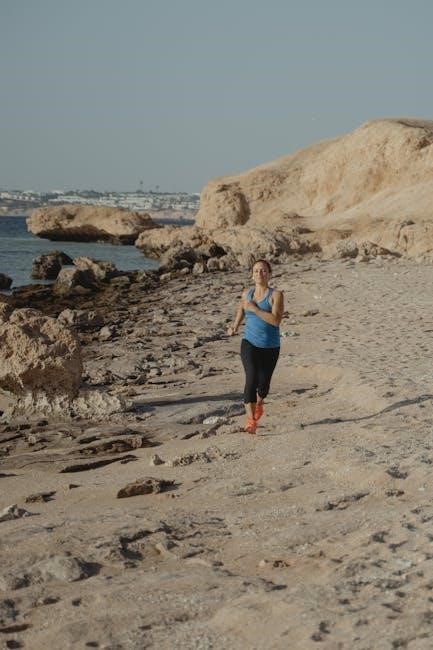
exercises for trochanteric bursitis pdf
Exercises for trochanteric bursitis are available in a downloadable pdf file, providing instructions and illustrations for rehabilitation, helping to alleviate pain and improve mobility, with a focus on gentle stretches and strengthening movements slowly.
Understanding the Condition
Trochanteric bursitis is a condition that causes pain and inflammation in the hip area, specifically in the bursae that cushion the joints. The condition can be caused by a variety of factors, including repetitive motion, direct blows to the hip, or poor posture. It is essential to understand the condition to develop an effective treatment plan, which may include exercises for trochanteric bursitis. A downloadable pdf file can provide valuable information on the condition, its causes, and symptoms. By understanding the condition, individuals can take the first step towards managing their symptoms and improving their mobility. The information available on the internet can help individuals learn more about the condition and how to alleviate its symptoms. With a clear understanding of the condition, individuals can work with their healthcare providers to develop a personalized treatment plan. This plan may include a combination of exercises, physical therapy, and lifestyle changes to help manage the condition and improve overall health.

Stretching Exercises
Exercises include piriformis stretch, hamstring wall stretch, and quadriceps stretch to improve flexibility and reduce pain, available in a downloadable pdf file with instructions.
Piriformis Stretch
The piriformis stretch is a gentle exercise that can help alleviate pain and improve mobility in the hip and buttock area. To perform the stretch, lie on your back with both knees bent and feet flat on the floor, then rest the ankle of the affected leg on the knee of the other leg. This will help to stretch the piriformis muscle, which runs from the base of the spine to the thighbone. The stretch can be held for 30 seconds and repeated several times, and it is recommended to start slowly and gently, especially if you are experiencing pain or discomfort. The piriformis stretch is one of the exercises included in the downloadable pdf file with instructions and illustrations for rehabilitation exercises for trochanteric bursitis, and it can be modified or adjusted to suit individual needs and abilities. Regular practice of the piriformis stretch can help to reduce pain and improve flexibility and range of motion.

Strengthening Exercises
Strengthening exercises, such as leg raises, help improve hip stability and reduce pain, with detailed instructions available in a downloadable pdf file for trochanteric bursitis rehabilitation exercises slowly.
Straight Leg Raise
The straight leg raise is a strengthening exercise that targets the muscles in the front of the thigh, helping to improve hip stability and reduce pain associated with trochanteric bursitis. To perform this exercise, lie on your back with the affected leg straight and the other leg bent, with your foot flat on the floor. Tighten the muscles on the front of your thigh, then lift your straight leg about 8 inches off the surface, keeping your knee locked. Hold for a few seconds, then slowly lower your leg back down to the starting position. Repeat this exercise 10-12 times, resting for 30 seconds between sets. It is essential to start slowly and gently, easing off the exercise if you experience any pain or discomfort. A downloadable pdf file is available, providing detailed instructions and illustrations for this exercise, as well as other trochanteric bursitis rehabilitation exercises. By incorporating the straight leg raise into your exercise routine, you can help improve your hip strength and mobility, reducing the symptoms of trochanteric bursitis. Regular exercise can help alleviate pain and improve overall hip function.

Hip Extension
The hip extension exercise is a valuable component of trochanteric bursitis rehabilitation, targeting the gluteal muscles to improve hip strength and mobility. To perform this exercise, lie on your stomach with your legs straight, then lift your top leg about 6 inches off the floor, focusing on lifting from your glutes. It is essential to feel your glutes working during this exercise. Lower your leg back down to the starting position, repeating the exercise 10-12 times. Rest for 30 seconds between sets, performing a total of 3 sets. This exercise can be modified to accommodate different fitness levels, and a downloadable pdf file is available, providing detailed instructions and illustrations for the! hip extension exercise, as well as other exercises for trochanteric bursitis rehabilitation. By incorporating the hip extension into your exercise routine, you can help improve your hip strength, reduce pain, and enhance overall hip function, which is crucial for daily activities and maintaining a healthy lifestyle with trochanteric bursitis. Regular practice of this exercise can lead to significant improvements in hip mobility and strength.

Additional Exercises
Exercises include hamstring wall stretch and clamshell, available in a downloadable pdf file for trochanteric bursitis rehabilitation, helping to improve mobility and reduce pain slowly every day.
Hamstring Wall Stretch and Clamshell
To perform the hamstring wall stretch, stand with your feet shoulder-width apart and lean forward, placing your hands on a wall for support, keeping your knees straight, and holding for 15-30 seconds. The clamshell exercise involves lying on your side with your knees bent and feet touching, then lifting your top knee away from your bottom knee, holding for a few seconds before lowering. These exercises can help improve flexibility and reduce pain in the hip and thigh area. A downloadable pdf file is available, providing detailed instructions and illustrations for these exercises, as well as others, to help with trochanteric bursitis rehabilitation. It is essential to start slowly and gently, easing off if pain occurs, and to consult with a healthcare professional before beginning any new exercise program. Regular practice can help alleviate symptoms and improve overall mobility and strength.
Quadriceps Stretch and Double Knee-to-Chest
The quadriceps stretch involves standing with one hand against a wall for balance, bending one knee, and grabbing your ankle with your hand, pulling your heel towards your buttocks, holding for 15-30 seconds; The double knee-to-chest exercise involves lying on your back, bringing both knees towards your chest, and holding for a few seconds before releasing. These exercises can help improve flexibility and reduce pain in the hip and thigh area. A downloadable pdf file is available, providing detailed instructions and illustrations for these exercises, as well as tips for proper technique and safety precautions. It is essential to listen to your body and ease off if you experience any pain or discomfort. Regular practice can help alleviate symptoms and improve overall mobility and strength, making it an excellent addition to a trochanteric bursitis rehabilitation program, and can be done in the comfort of your own home, with minimal equipment required, and can be modified to suit your individual needs and abilities.


Leave a Reply
You must be logged in to post a comment.